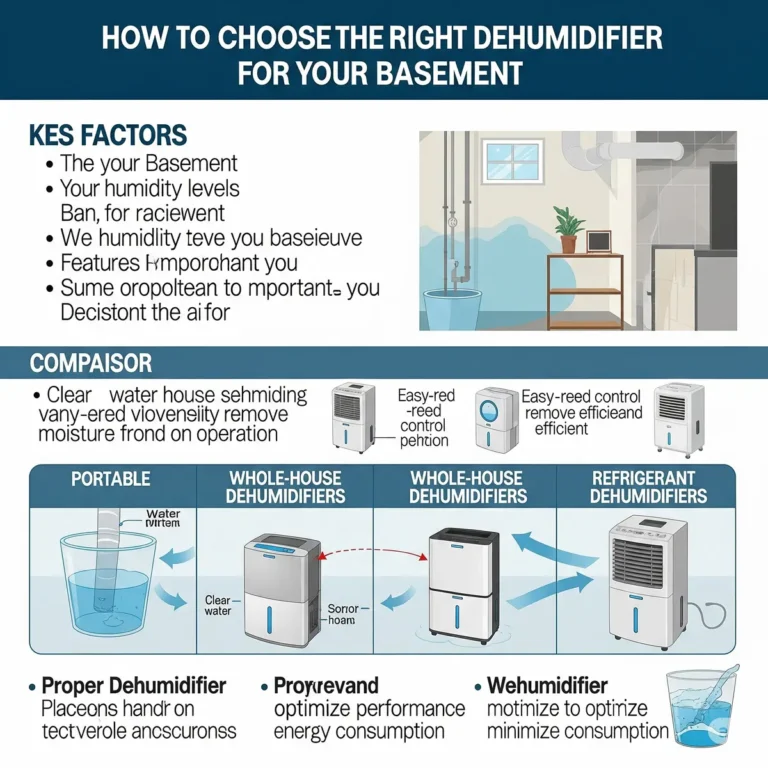How to Maintain Dehumidifier for Basement Use
So you’ve invested in a dehumidifier to keep your basement dry, and now you need to make sure it’s working as efficiently and effectively as possible. And how to maintain a dehumidifier for basement use. Like any other product, a dehumidifier requires proper maintenance to continue serving you for a long time. When it comes to our air conditioners, most of us assume that we can set it and forget it. But that doesn’t have to be the case—with regular maintenance and care, your dehumidifier can prevent basement mold by continuing to extract moisture from the air at an effective rate.
The upkeep of your dehumidifier isn’t just about keeping it running well—it’s about ensuring that your basement is not damp, moldy, and uncomfortable for your family. Whether it’s running to keep humidity levels in check or to prevent mold, regular maintenance is what will help keep it in your home for a long time.
How to Maintain Dehumidifier for Basement Use Regularly Clean the Filters
Your dehumidifier’s filters are an essential part of its operation. They trap dust, dirt, pet hair, and other pollutants, thereby preventing them from getting into the air from your basement. Should your filters get clogged, then the airflow will be limited, and this will cause your dehumidifier to need to work harder, which in turn reduces its efficiency.
How to Clean a Dehumidifier Filter:for Maintain a Dehumidifier
Many dehumidifiers feature reusable filters that you can remove to clean. Begin by closing the unit down and disconnecting it. Take out the filter and rinse with warm water to remove dust and dirt. Try not to use abrasives or harsh chemicals, as they can ruin the filter. For a heavily clogged filter, you may need to use a vacuum cleaner to help effectively loosen the debris.
Frequency:
You will need to clean the filter biweekly to monthly, depending on how damp or dry your basement is. If you’re in a more humid climate, or if your basement is extra dusty, perhaps clean the filter more frequently.
Frequent Emptying of Water Tank moisture management
Dehumidifiers trap water in a reservoir. If your unit doesn’t have this feature, you’ll need to empty your water tank frequently to keep the dehumidifier running. And if it’s not checked during use, the tank can fill up, and the unit will stop working until it’s emptied. If you’re running the machine 24/7, this may mean having to empty the tank a few times a day during humid weather.
Why Empty the Water Tank:
Dehumidifiers for basement use were maintained as if the water tank were full; the dehumidifier will not be able to remove moisture from the air. Standing water can also promote the growth of bacteria, mold, and mildew inside the tank, potentially undoing all your hard work in keeping the rest of your basement dry.
Pro Tip: For your air moisturizer
If you don’t want humidity control tips or the trouble of having to empty the tank, choose a dehumidifier that has a continuous drainage option available. That means you don’t even need to empty the pan by hand; you can allow water to flow directly to a basin or floor drain.
Inspect the Drainage System
And if you have a drain hole in your dehumidifier, keep an eye on it too for clogs. Leaking and heavy-duty shutoff A clogged drainage system can allow water to be pumped back into the unit, destroying seals and O-rings and also causing the unit to fail. You should also be aware of kinks in the hose because they will stop the water from draining as it should.
Drainage System Cleaning Methods:
To avoid clogging, clean the drain hose every few months. You can flush them with warm water to get rid of any sediment or mold that may be inside. Some people scrub the hose with a pipe cleaner or a soft brush.
Pro Tip: For Humidity device
Just make sure the hose is leading to a place where you can deal with the moisture, like a floor drain, a sump pump, or a sink. If it runs out on the floor, it could present another moisture issue.
Check the Coils and Fans
The evaporator and condenser coils in your dehumidifier are important components for removing moisture from the air. These parts also get dirty if not cleaned periodically, which limits how well the unit can dehumidify. The cleaner you keep your coils and fan, the more efficiently your unit will work.
How to Clean Coils and Fans:
Clean the dehumidifier with it off and unplugged. Clean the coils with a soft cloth or brush—be cautious when removing debris to avoid damaging the coils. If needed, you can clean these dirty coils with a coil cleaning solution that is safe for your specific unit. Be sure to refer to the owner’s manual for the method to clean these parts.
Pro Tip:
And don’t overlook the fan blades. The blades of your fan can also get dusty and hold onto other debris, which means it will have to work harder, taking away from the overall efficiency of your dehumidifier.
Annual Maintenance Check
At a minimum of one time per year, give your dehumidifier a complete maintenance check. Doing this will help you avoid surprise problems and keep the unit running in top form. If your filter needs a good cleaning, now is a great time to do it. “You don’t want to wait until humid season to start this thing up,” Mr. Berger said.
How to Annuallyly Maintain a Dehumidifierer for Basement Use: Things to Check On:
Inspect the unit or drain system for leaks.
Check the fan motor to see if it is running well.
Inspect the housing for any cracks or signs of damage.
Make sure that all settings are working.
If the filter or water tank is worn out, replace those parts.
It is essential to keep your dehumidifier for basement humidity control in the best possible condition for long life and maximum performance.
Routine cleaning and inspection of the drainage system, as well as annual maintenance, will ensure your basement stays dry and save you money in the long term by limiting the amount of work/expensive replacement repairs you need to make.
The time you invest in these actions now will be worth the payback in a longer life for your dehumidifier (which in turn protects against mold) and a more comfortable (and less smelly) basement.




